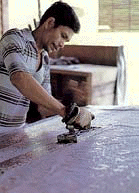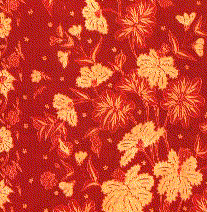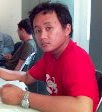Saturday, July 08, 2006
Batik of Central Java

 Batik is generally thought of as the most quintessentially Indonesian textile. Motifs of flowers, twinning plants, leaves buds, flowers, birds, butterflies, fish, insects and geometric forms are rich in symbolic association and variety; there are about three thousand recorded batik patterns.
Batik is generally thought of as the most quintessentially Indonesian textile. Motifs of flowers, twinning plants, leaves buds, flowers, birds, butterflies, fish, insects and geometric forms are rich in symbolic association and variety; there are about three thousand recorded batik patterns. The patterns to be dyed into the the clothe are drawn with a canting, a wooden 'pen' fitted with a reservoir for hot, liquid wax. In batik workshops, circles of women sit working at clothes draped over frames, and periodically replenish their supply of wax by dipping their canting into a central vat. Some draw directly on the the cloth from memory; others wax over faint charcoal lines.
This method of drawing patterns in wax on fine machine-woven cotton was practiced as a form of meditation by the female courtiers of Central Java; traditionally, batik tulis (tulis means 'write' in Indonesian) is produced by women.
In the 19th century, the application of waxed patterns with a large copper stamp or cap saved the batik industry from competition with cheap printed European cloth. The semi-industrial nature of cap work allows it to be performed by men. Batik motifs recall characters from the Hindu epics, plants, animals, sea creatures and gamalan melodies.
| The palette of the north coast were influenced by lively maritime trade and the textile traditions of the Chinese and Arab mercantile communities living in port and coastal towns. |
<< Home

